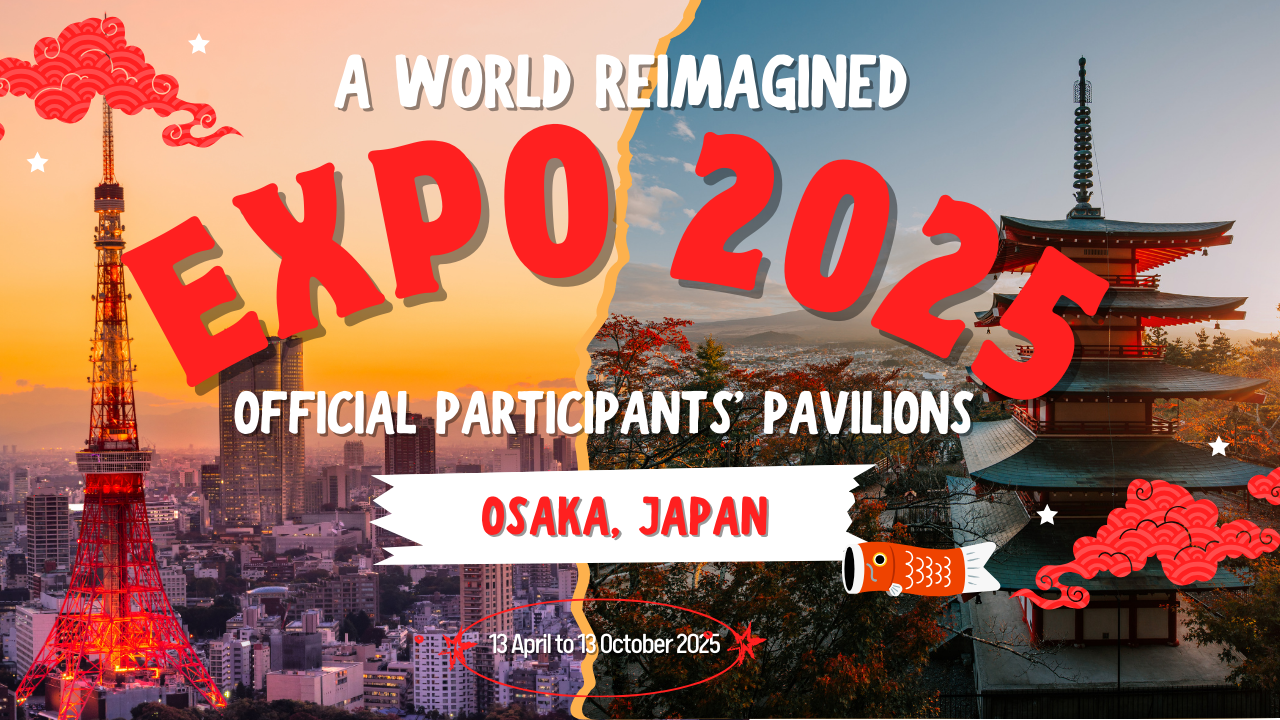When Osaka opens its arms to the world in April 2025, the Expo grounds on Yumeshima Island will transform into a living world map. Here, national pride fuses with global imagination, and each pavilion becomes a cultural ambassador. With the theme “Designing Future Society for Our Lives,” Expo 2025 offers more than spectacle: it is a laboratory of futures, where nations and organizations re-envision the art of living together.
Below is a journey through the Official Participants’ Pavilions, a constellation of stories and designs that together form the heart of the Expo.
1. Africa’s Rising Voices
- Algeria introduces visitors to its blend of desert heritage and renewable futures, presenting the Sahara not only as a cultural cradle but also as a solar frontier.
- Egypt carries echoes of its timeless monuments, but its pavilion turns eyes forward—toward sustainable water use and food security.
- Mozambique and Senegal showcase the dynamism of African coastal life, from blue-economy initiatives to vibrant music and art.
- Tunisia strikes a balance between Mediterranean traditions and modern innovation, hinting at Africa’s pivotal role in bridging continents.
2. Asia Pacific: Tradition Meets Technology
- Australia tells a story of land and sky, blending Indigenous narratives with innovations in biodiversity and clean energy.
- Bangladesh places climate resilience at the center, highlighting how vulnerable nations lead in adaptation strategies.
- China presents a sweeping vision of urban futures, with AI, smart cities, and green technology at its core.
- India dazzles with a pavilion that spans from Ajanta art to artificial intelligence, embodying the continuity of heritage and innovation.
- Indonesia, Malaysia, Philippines, Thailand, and Vietnam embrace Southeast Asia’s diversity, highlighting food, crafts, and digital futures.
- Korea blends pop-cultural vibrancy with robotics and advanced healthcare, while Japan’s domestic regional pavilions echo in unison across the Expo.
- Oman and Qatar bring desert architecture into the 21st century, exploring themes of resource stewardship and connectivity.
- Singapore imagines the city-state of tomorrow: green, vertical, and hyper-connected.
- United Arab Emirates revisits its Expo 2020 Dubai success, presenting a forward-looking pavilion on sustainable growth.
- Uzbekistan and Turkmenistan highlight Silk Road legacies, now reframed through modern architecture and regional innovation.
3. Europe: A Laboratory of Design and Sustainability
- Austria, Belgium, and Czechia transform their engineering prowess into architectural poetry.
- Denmark, Finland, Norway, and Sweden showcase the Nordic Pavilion ethos: minimalism, circular design, and deep respect for nature.
- France and Germany focus on green transitions, digital transformation, and artistic experiences that resonate across generations.
- Hungary and Poland highlight resilience, from water management to energy independence.
- Italy offers design elegance rooted in Renaissance aesthetics but framed for a sustainable future.
- Luxembourg and Monaco underscore how small nations punch above their weight in finance, culture, and technology.
- Netherlands leads with its expertise in water and agriculture, with plans to relocate its pavilion to Awaji Island after the Expo.
- Portugal, Romania, Spain, and Switzerland spotlight Mediterranean and Alpine innovations: food systems, clean energy, and heritage as a springboard for creativity.
- United Kingdom presents itself as “Great Britain and Northern Ireland,” emphasizing science, cultural exports, and a post-Brexit vision of global connectivity.
- Turkey serves as a Eurasian bridge, showcasing heritage and future-oriented trade.
4. The Middle East’s Cultural Renaissance
- Bahrain, Kuwait, and Saudi Arabia lean into architecture inspired by desert topographies, while also telling stories of energy diversification and youth innovation.
- Jordan embraces its archaeological marvels while presenting itself as a hub for cultural diplomacy.
5. The Americas: From Arctic to Andes
- Canada invites visitors into a multi-sensory pavilion of forests, lakes, and Indigenous wisdom, paired with cutting-edge science.
- United States of America blends entrepreneurial energy with narratives on space exploration and AI.
- Colombia and Peru offer a rich interplay of biodiversity and cultural heritage, from the Amazon to the Andes.
6. Global and Multilateral Participation
- European Union (EU) builds on the idea of unity in diversity, highlighting continental cooperation on climate, tech, and culture.
- United Nations (UN) provides a broader stage, framing global goals and collective futures that transcend national boundaries.
- Holy See (Vatican City) offers a moral and spiritual counterpoint, drawing attention to ethics and peace in an era of technological acceleration.
- Intergovernmental organizations like the International Red Cross and Red Crescent Movement foreground humanitarian action in the face of global crises.
Why These Pavilions Matter
Each of these official participants contributes not just exhibits but narratives of identity, survival, and aspiration. Together, they form a global conversation:
- Sustainability runs like a green thread—from Nordic timber design to African renewable energy.
- Technology and AI stand tall in East Asia, the U.S., and Europe, promising to rewire daily life.
- Culture and resilience shine in the Global South, reminding visitors that heritage is itself a kind of innovation.
- Unity and diversity are embodied in organizational pavilions, showing how nations can align without losing individuality.
Final Thought
Expo 2025 Osaka is more than an architectural exhibition—it is a world condensed, a future rehearsed. Walking through these pavilions, visitors will not only glimpse what nations dream for themselves, but also what humanity dares to imagine together.





